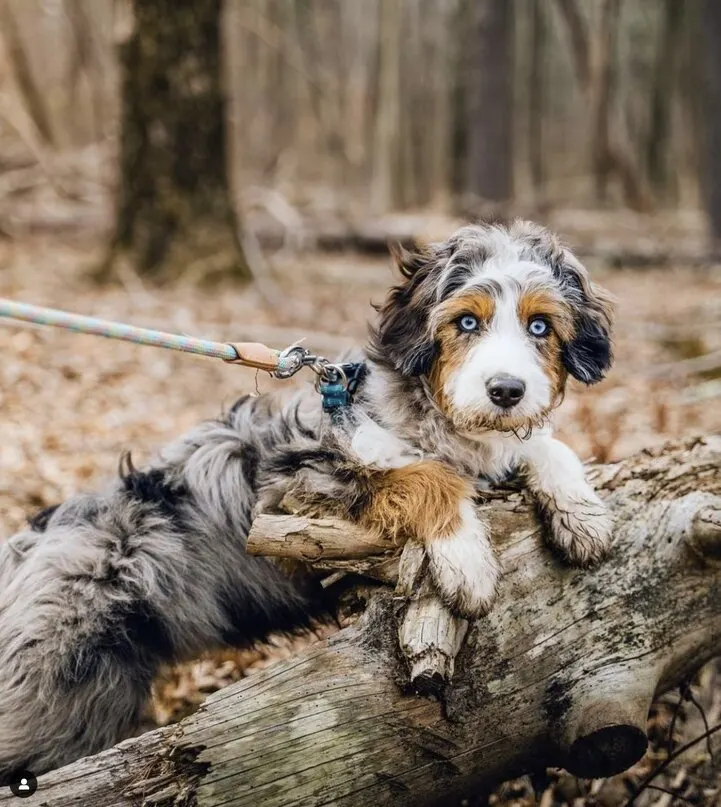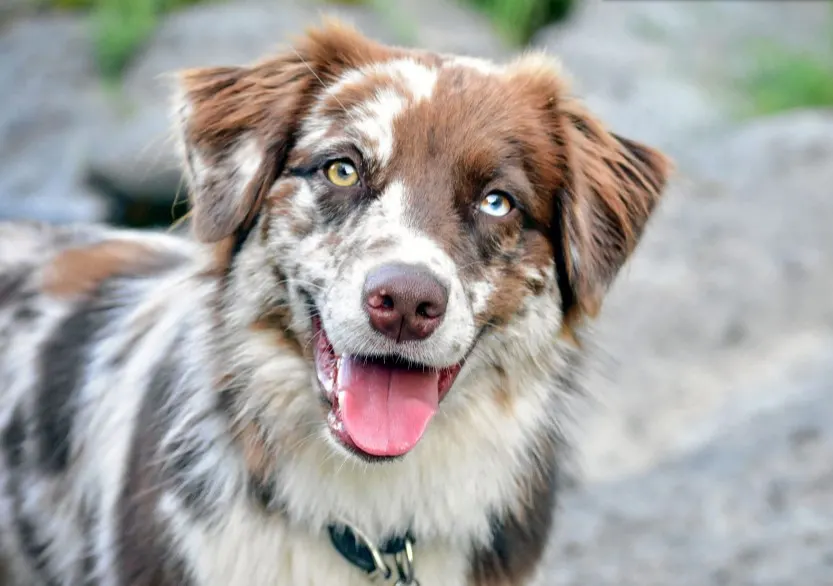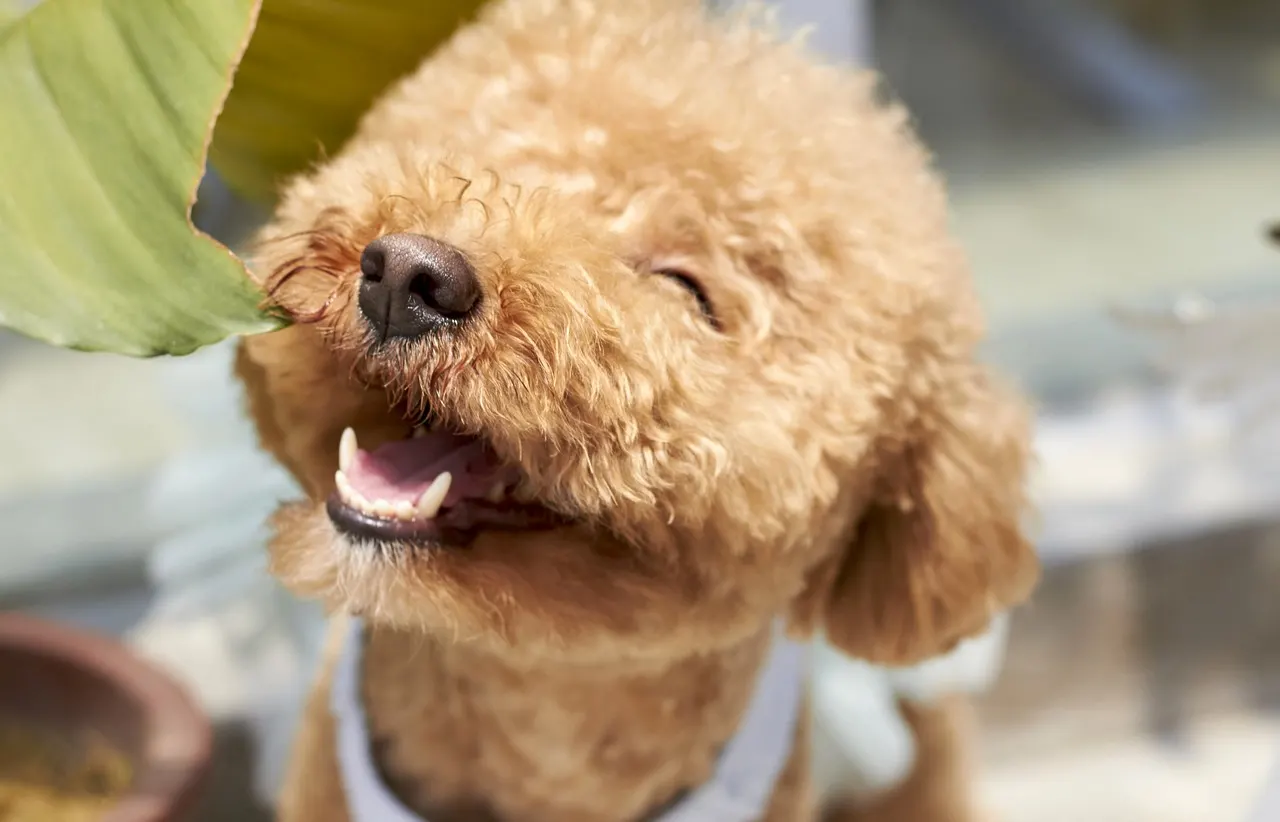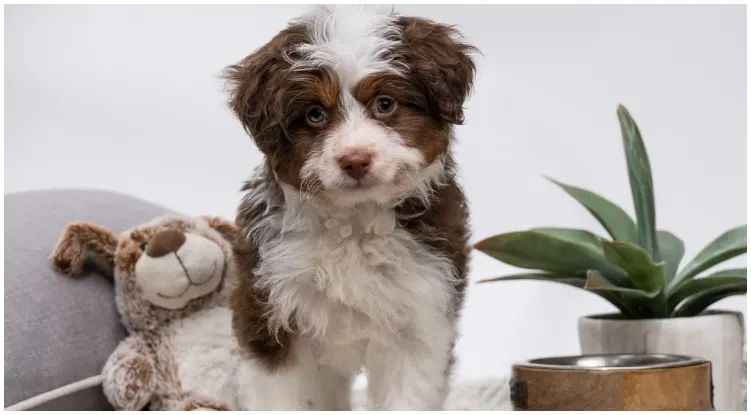If you are looking for a new dog to adopt into your family — then put the Mini Aussiedoodle on the top of your list. The Mini Aussiepoo is a fairly new breed and will win your heart the moment you meet them.
This is a mixed dog breed of the Miniature Australian Shepherd and the Miniature Poodle. And there’s a good reason why the Mini Aussiedoodle is so popular lately. Both of his parent dog breeds are loyal, incredibly intelligent, and affectionate dogs. And it’s no wonder that their crossbreed will be equally as admirable. Because this is a mixed breed, they are not recognized by the American Kennel Club or any other kennel club.
Besides their high intelligence, these canines are also cute as a button! Yes, they combine both — beauty and brains! This little ball of fur and energy will turn your life upside down and you will be left asking yourself why you didn’t get one earlier. But be warned — if you are a couch potato that loves to stay inside, this dog isn’t the one for you.
But let’s not come to conclusions too early. Instead, let’s learn the basic info about the Mini Aussiedoodle. Shall we?
History of the Miniature Aussiedoodle
The Miniature Aussiedoodle is a cross between a Miniature Australian Shepherd and a Miniature Poodle, resulting in a dog with exceptional brains! The crossbreed of the dog itself has a 20 to 30-year history. It’s unclear when exactly the first Mini Aussiedoodle was introduced. But, it’s believed that it was somewhere during the designer breed craze of the 19080s and 1990s. We do know that they have been developed in the United States and the goal with this mix was to create a dog for companionship, agility training, and obedience training.
At first glance, the Miniature Australian Shepherd parent breed appears to be a crossbreed, but in reality, the dog breed is created by carefully breeding the smallest purebred Aussie pups in litters to other smaller purebred Aussie pups, allowing breeders to create a smaller version of the Australian Shepherd while maintaining the same dog breed characteristics and keen sense of the larger breed.
This cautious and purposeful breeding strategy has resulted in exactly the type of canine that was initially planned, thus the dog breeders should be applauded. In the 1960s, the Miniature Australian Shepherd dog breed was brought to the United States, and the small version was produced in 1968 using the aforementioned breeding principle for agricultural and herding reasons.

Separate breed or not?
The Miniature Aussiedoodle was created by crossing it with the Miniature Poodle. The Miniature Australian Shepherd is a smart dog who is well-suited to any canine activity. Agility, herding, obedience, disc dog, fly ball, and general cherished fuzzy family member are examples of these hobbies.
After years of debate over whether the miniature version of the Australian Shepherd was a separate breed from the larger version, with both the American Kennel Club and the United Kennel Club previously classifying the two dog breeds as one, the American Kennel Club finally listed the Miniature Australian Shepherd in the Foundation Stock Service in 2011, allowing it to be recognized once registration numbers reach 150.
The Miniature Poodle breed was developed over 500 years ago in response to a need for a smaller version of the well-known standard Poodle, one that would be easier to care for and feed. Due to their simplicity of training and intelligence level, the small dog breed became quite popular among circuses in the 1950s and 1960s. The little Poodle is still a very energetic canine with hunting traits similar to the standard Poodle, which is one of the oldest dog breeds known.
Even though both of these dogs are pretty small, don’t be fooled! They have the biggest personalities! We are sure that you will fall in love with your Aussiedoodle and that he will become your best friend instantly.
Miniature Australian Shepherd
In the 1960s, the Miniature American Shepherd was created. Small Australian Shepherd dogs used in rodeos were selectively bred by American ranchers. As a result, they made even smaller breed clones.
Miniaturization of a canine breed can usually be accomplished in one of three ways, each with its own set of benefits and drawbacks:
- Combine a larger dog breed with a smaller dog breed to create a hybrid
- Add the dwarfism gene to the mix
- Breed from the litter’s runts regularly
The third choice was used to create the Miniature American Shepherd. Modern small Australian Shepherds, on the other hand, can be made using any of these three.

Mini or teacup Australian Shepherd dogs will vary in appearance based on the method used to produce them. Puppies raised over generations from little Australian Shepherds are the most likely to resemble a reduced version of the conventional breed.
Those created through introducing dwarfism typically have very small legs and disproportionately large heads. Crossbreeding to produce smaller puppies, on the other hand, results in dogs that can inherit any combination of features from either parent.
Colors and coat type
The Miniature American Shepherd’s magnificent coat is one of its most eye-catching and well-loved qualities! Breeders work hard to recreate this in smaller versions of the breed. The Miniature American Shepherd exemplifies this trait.
Teacup Australian Shepherds can be any of the following:
- black
- blue merle
- red
- red merle
They can also have tan and/or white markings.
What is the size of a Mini Australian Shepherd?
Mini Australian Shepherds are smaller than ordinary Australian Shepherds, as we’ve established. But how big can an adult mini Australian Shepherd get? The shoulder height of a Miniature American Shepherd can range from 13 to 18 inches. They are between 20 and 40 pounds in weight.
Males are larger than females in general.
So this breed isn’t very little, weighing in at around 20–35 pounds less than a standard Australian Shepherd. Modern small Australian Shepherds come in a wide range of sizes, depending on how they were bred.
The temperament of a Mini Australian Shepherd
The small Australian Shepherd’s personality is likely to be characterized by a good work ethic and a love of herding animals, just like their full-sized relatives.
If we talk about mini Aussies created more recently through crossbreeding they can have traits of the other parent breed as well.
The small Australian Shepherd is often easy to teach, loyal to its owners, and eager to please. But, remember that a bored and lonely Aussie of any size may be rather destructive! To prevent them from being hostile or snappy toward non-family members, you’ll need to socialize them. But this is the case with every breed.
Teacup or mini Australian Shepherds, despite being smaller than the usual breed, can be dangerous if they are aggressive. Which is another reason to pay extra attention to socializing them.
Furthermore, the breed is very energetic and does not fare well if not allowed to burn off excess energy outside.
If the small Australian Shepherd is not engaged as a working dog, he might end up biting you and your family members (especially young children) and try to herd you.
Miniature Poodle
Poodles are a very popular breed that comes in three different sizes:
- miniature Poodle,
- toy Poodle and
-
standard Poodle which is used to develop standard Aussiedoodles
But, for creating the Mini Aussiedoodle generally, breeders use the miniature Poodle or mini Poodle. That is the best way to create tiny dogs. But, let‘s talk more about the Miniature Poodle.
Appearance and size
Miniature poodles are small dogs that stand 10–15 inches tall and weigh 10–15 pounds. Because of their roots as water retrieving dogs for duck hunters, tiny poodles have athletic, muscly bodies, just like their standard and toy-size cousins.
Mini Poodles have curly coats, lively features, and dark eyes. While show poodles usually wear the sophisticated continental haircut, which includes curling pom-poms meticulously molded and clipped around the joints and chest, most tiny poodle owners prefer the low-key sporting clip.

The mini Poodle comes in many available colors:
- black,
- white,
- apricot,
- grey,
- silver,
- brown.
With a tiny poodle around, you won’t need to stock up on lint rollers because the breed sheds very little. While no dog is entirely hypoallergenic, poodles of all sizes can be an excellent choice for allergy sufferers.
Temperament
Miniature poodles are intelligent, energetic, and lively. As pups and young dogs, they enjoy romping and playing almost nonstop. Although their activity levels alter as they grow older, you can still expect your miniature poodle to be quite active as an adult dog.
Poodles are simple to teach and like surprising their humans. Their reactions to new people can range from pleasant and polite to hesitant and frightened. Help your mini out by socializing them early and giving them a stable, conflict-free living setting; their sensitive nature can lead to hypersensitivity and anxiety. These traits might be one reason why the mini Poodle isn‘t a great choice for families with small children.
Because of their non-shedding coats, miniature poodles are generally a good choice for allergy sufferers. Still, just because they don‘t shed doesn’t shed, it doesn’t mean they have a low-maintenance coat. To avoid matting you still have to brush them every day. Miniature poodles require regular grooming even if they’re given a simple one-length-all-over sporting clip.
The appearance of the Mini Aussiedoodle
The Mini Aussiedoodle is living up to his name. Therefore, they are a small size dog breed. Both male and female Mini Aussiedoodles can grow 12 to 18 inches tall. They weigh somewhere between 15 to 25 pounds.
They are of a tiny frame and make great dogs for people with smaller apartments.
Because they are crossbred, their appearance might be unpredictable. It all boils down to which genes are expressed for each youngster – each puppy in the same litter can appear drastically different.
The Aussiedoodle might resemble an Australian Shepherd, a Poodle, or be an equal cross between the two! There is no way of knowing until the puppy is fully grown.
Coat colors
Their teddy bear appearance, on the other hand, is unmistakable. They usually have shaggy and fluffy fur, floppy ears, and sweet eyes. Their coat and color, like their size, are unexpected!
The Australian Shepherd is available in
- black,
- blue merle,
- red, and
- red merle.
They may also have tan points and white patterns on their bodies.
Poodles are even more diverse than Aussie Shepherds, their coat colors include:
- apricot,
- black,
- blue,
- brown,
- cream,
- white, and
- red.
So, depending on their parents’ genes, your Aussiedoodle might be any of the mentioned colors. In terms of coat, depending on which parent breed‘s traits they inherited, they can have one of two types of coats:
- they could have a soft and curly coat like a Poodle
- they could have a straight or curly coat.
Also, because the Australian Shepherd has a double coat, your adorable hybrid can have one as well.
The temperament of the Mini Aussiedoodle
Mini Aussiedoodles are awesome dogs! They are loyal, social, brave, outgoing, and gentle. Can it get any better than that? But, due to their incredibly high intelligence, they can also be a bit stubborn. But only if not trained well.
Due to their gentle nature and overall friendliness, the Mini Aussiedoodle is a great dog to have around children, guests, and even other pets. Make sure to start the socialization process early so that your canine has the best social skills possible.
Due to their lovable personality, they don’t make a good watch or guard dogs. They just love people and cuddles too much! Their intelligence and people-pleasing attitude allow them to be super trainable. You will have the best time teaching your Mini Aussiedoodle commands and tricks.
But, a sociable personality also has a bit of a downside. They just can’t be left alone for long periods. Otherwise, they can develop destructive behaviors and even damage things in your home. That’s why a dog sitter will be a must.
Grooming your Mini Aussiedoodle
Poodle genes are to blame for your Miniature Aussiedoodle’s fine, soft, wavy coat. It is low- to non-shedding meaning it doesn’t shed very much or at all. It is important to brush them 2 or 3 times a week and that groomed often to keep his coat in shape.
So, when it comes to taking care of, the Miniature Aussiedoodle is a dog that doesn’t need a lot of work. The Mini Aussie’s coat is hypoallergenic, which makes them a good choice for anyone who has allergies or has trouble breathing.
Because he has floppy ears, you should check and clean his ears every week to avoid painful infections. Keep their ears in good condition too. It will pay off in the long run. This means you need to clean your Mini Aussie’s ears often and take them to the vet for a dental cleaning. This helps to keep their ears and teeth from getting infected, which can be bad for their health if they don’t get treated right away.
Dogs can get periodontal disease, which causes their teeth to fall out. This will happen if their teeth aren’t cleaned at least twice to three times a week, or even every day, at home. Check and cut your dog´s nails every week as part of thier grooming. The mix will not need to be bathed unless it is very dirty. This is to keep the important oils in the coat and not to wash them away.
Exercise needs and Health of the Mini Aussiedoodle
Even though they are small, these dogs are still playful and energetic. Very energetic. 40 to 60 minutes of exercise each day are therefore a must for every Aussiedoodle. A short walk won’t be enough. They need walks, jogs, hiking adventures, but also interesting games like fetch or scavenger hunts.
In addition to that agility or obedience training exercises could also help a lot. But only after your dog turns one year old. Always make sure your dog is wearing a leash. These energetic dogs have no problem running away if there see something more interesting in the distance. They inherit the hunting and tracking instincts of their Mini Australian Shepherd parent. Therefore it’s better to be safe than sorry.
Health problems
Mini Aussiedoodles can develop health conditions common to both Mini Australian Shepherds and Mini Poodles. This is especially common if you aren’t cautious about which breeder you buy your puppy from. The possible health conditions include:
- hip dysplasia,
- cataracts,
- progressive retinal atrophy,
- epilepsy,
- autoimmune thyroiditis
- a skin disease called sebaceous adenitis.
Other health issues
When dogs are mixed breeds, they don’t usually get sick like their pure-bred parents. But even so, it is always a good idea to be aware of what your dog might get from its parent breed.
Besides the already mentioned health problems you should also look out for the following issues:
- joint issues,
- hypothyroidism,
- drug sensitivity
- Von Willebrand’s
It’s important to have your dog checked out by a veterinarian on a regular basis, especially as he or she gets older. This way, any health problems can be found and treated as soon as possible. Even if your dog looks healthy and happy, it’s worth going to the vet just in case something happens that isn’t obvious. To keep your dog healthy and happy, you should also feed them food that is good for them.
The good news is that most Mini Aussiedoodles are healthy and happy dogs. Their average lifespan is between 10 and 13 years.
Final thoughts on the Mini Aussiedoodle
The Miniature Aussiedoodle or Mini Aussiedoodle is an amazing dog that can adapt to almost any living situation, as long as they get plenty of exercise. Because this mixed breed was developed by crossing two of the smartest breeds, the Poodle and Australian Shepherd, the intelligence of the Miniature Aussiedoodle is out of this world. With this mixed breed you are getting the best deal and the best companions you could have wished for.
Even though they would make good family dogs for almost everyone, just like any other breed, this mix has certain needs as well. We did say that they can adapt to any living situation, but the truth is they have very high energy levels so they will thrive with active families that have an active lifestyle. People who love being outside and go on hikes and runs.
Price
We can‘t end this article without talking about the price of Miniature Aussiedoodle puppies. Miniature Aussiedoodle puppy prices vary widely. Mini Aussiedoodle puppies are a rare breed and typically cost around $2,500, but the price will be heavily influenced by the parents’ temperament, health, and the color of the dog’s coat. Some may be found for as little as $800, but be wary if the price appears to be too good to be true. Because the puppies that are not properly bred or that are from puppy mills will usually cost a lot less money. Our advice to you is to always purchase pups from reputed breeders. Also, know that the best Aussiedoodle breeders will usually charge a lot more money. Find the best Mini Aussiedoodle breeders in your area by asking your vet for recommendations or friends who already have a Mini Aussiedoodle.
If you don‘t find a good breeder right away, don‘t give up. It is just a matter of time when you will find a reputable breeder.
Read some of our other articles:
- These Two Golden Retrievers Had Different Reactions To Their First Snow
- Bergamasco Sheepdog: The healthiest breed ever?
- Otterhound Dog Breed: Facts, Informations And Traits
- Whippet Dog Breed: What You Should Know
- Airedale Terrier Dog Breed: All The Facts You Need
- Pitbull Husky Mix: Meet The Pitsky
- White Cane Corso: The Italian Mastiff
- Blue Tick Beagle: The unusual looking purebred

